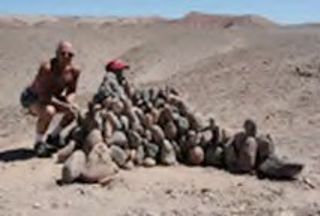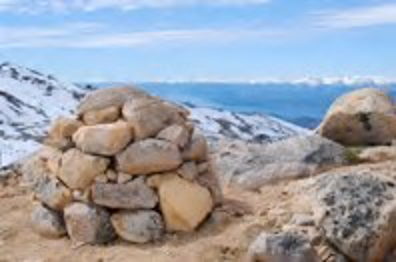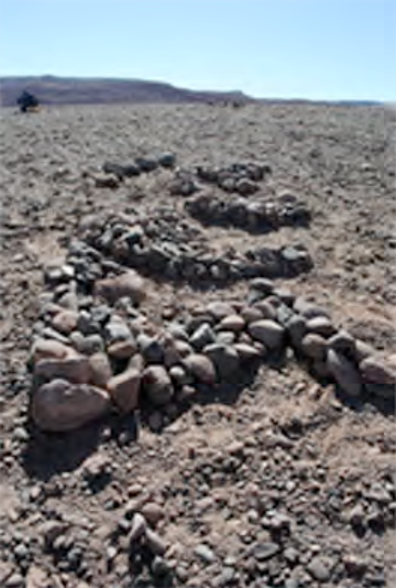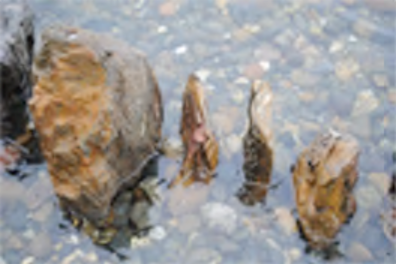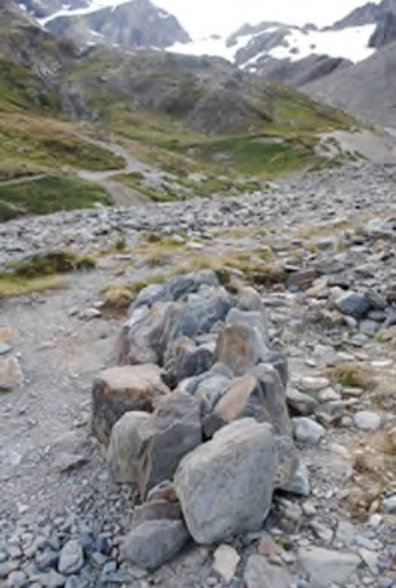Dennis A. Winters
TALES of the EARTH : Landscape Architecture, Toronto www.talesoftheearth.com gardens@talesoftheearth.com
Heart of a continent, centre of cosmology — what does it take to grasp meaning of such an incomprehensible landscape? While intellectual inquiry and analysis provide a foundation for ‘left-brain’ understanding, research has its limits, bound by perspectives demanding ‘objectivity.’ This workshop provides a provocative way to cultivate profound introspection into the nature of cosmological form and space by physically moving stone and sand on the beach to create artistic ‘subjective’ visions of sacred landscape.
What mind occupies these landscapes? – I’d ask
sketching, making things of stone, learning to be in this place —
Brought to my knees by the glory of sacred landscape, how to formulate what I don’t understand? I find clues by becoming quiet to cultivate clarity, becoming sensitive to landscapes’ formation and meaning. I configure a relationship with it, negotiating willingness to explore and become naked. Constructing things with stone and sand, wondering if I simulate ways that people inhabit landscape and devise ideas of cosmological origin and identity.
Similarly, this workshop will simply go to the beach on Isla Mujeres, assess available resources and build landscapes of stone and sand, individually or in teams, in the allotted time. The presence / absence of materials will provide portals to questioning how the reproductive operations of nature contribute to ideas of cosmology and participants’ mutual relationship to these processes.
For grounding, the workshop first will review six signs of sacred landscape as a design procedure; and, for inspiration, discuss two distinct precedents of physical geographies and corresponding constructions of form and space that interpret their cradles of origin. Enabling both objective discussion and subjective artistry to cosmological makings will give guidance to making things of stone and sand, and the potential for creating sacred landscape within oneself and one another, the mind occupying these landscapes.
Landscape precedent one: Three thousand years ago people settled shores, foothills and open plains of Lake Titicaca, largest lake in the Andes altiplano. The lake’s immense size and depth provided moisture and warmth unavailable to the rest of the region, with fertile waters and lands for farming, pasture and natural resources, enabling exchange of goods with people of other ecological zones.
Because of its unusual qualities, setting and configuration, Lake Titicaca came to be identified with Andean Genesis. From Isla del Sol within this sacred lake, Creator Viracocha emerged to organize the universe, mediating between dualities of celestial and natural patterns, tangible features and qualities in the landscape: movements of sun, moon and stars, day and night, seasons; male principles of height, dryness, aggression, activity; and female principles of depth, wetness, fertility, passivity.
If the Andes forms the spine of South America,
Lake Titicaca is the Heart, all the continental mass pointing to this highest body of freshwater at 3800 metres above sea,
axis mundi connecting Heaven and Earth —
Making things of stone, learning to be in this place a thousand years later, shamans reconstructed this cosmology at the city of Tiwanaku, aligned in cardinal directions following the sun’s path, in an auspicious location between Lake Titicaca and revered snow-capped Mount Illimani. Together the natural space of Lake Titicaca and the constructed form of Tiwanaku became known as taypiqala, Aymara for, “stone in the centre.”
A surrounding moat produced an island, heart of the centre. Architecture expressed cosmic order, axis mundi between heaven and earth in cardinal directions. Terraced platforms surrounding sunken courtyards linked human and nature, maintaining balance and harmony. Akapana pyramid, half an Andean cross of seven terraces, evoked sacred mountains of Isla del Sol. The Gateway of the Sun faced east to the rising sun and Mount Illimani.
Incas traced its origins to Lake Titicaca and dynastic heritage to Tiwanaku’s ancient kings, emulating its physical symbols of power. Some have asserted Tiwanaku as heart of all the Americas, cosmological centre of the entire western hemisphere. Migrating Tiwanaku culture throughout the continents was thought responsible for each Western Hemisphere civilization – intriguing Chichen Itza connection.
Here, landforms come alive undulating topography, granite and sandstone outcrops, ridges and valleys, lands and waters dancing the Great Salsa Pachamama’s orchestrations.
Landscape precedent two: Mount Kailas in remote Western Tibet, holiest of mountains, is sanctuary to deities of Hindu, Buddhist, Bon-po and Jain. Early Indus Valley travelers discovered Mt. Kailas rising high above the Tibetan Plateau. Each facet of Mt. Kailas bathed surrounding landscapes with light – gold on the north, silver on the east, lapis on the south and crystal on the west. Travelers discovered that the holy mountain was the source of South Asia’s four major rivers. They thought it to be Mount Meru, cosmological centre ofthe classic single, circular world system: four continents and intermediate continents, celestial rivers flowing to cardinal directions, concentric mountain ranges and seas, and the chakravala, outermost circular wall. Tibetans revere Mt. Kailas as the purified environment of the omniscient mind, calling the mountain Kang Rinpoche, Precious Jewel of Snow.
Making things of stone, learning to be in this place a thousand years later, King Trisong Detsen and Guru Padmasambhava directed re-construction of a cosmological mandala in the exquisite, auspicious and fertile Samye Valley – landscape and monastery complementary expressions of the Pure Land. They perfectly aligned this first Tibetan Buddhist monastery according to geomantic principles. Within the centre of the chakravala wall of four cardinal gates and 1008 chortens is the Utse Rigsum Tsuklakang, mind of the Buddha and embodiment of Mount Meru; with four Ling Temples of the Four Continents in cardinal directions, Ling-tren temples of the subcontinents, Four Self-Originating Chortens of Intermediate Directions, and Sun and Moon Temples. Samye as translated is “unimaginable.”
Summarily, the workshop – reviewing design procedure and precedents; making things of stone and sand on the beach, learning to be in this place (Isla Mujeres), creating visions of sacred landscape – provides grounds for cultivating ideas of cosmological origin and identity at Chichen Itza … the mind that occupies this landscape.
Workshop preparation notes:
- I will arrive at Isla Mujeres Thursday, March 29th, several days before the symposium begins to reconnoiter beaches for most suitable places to build. Although Favourable Context (proper location) is the first sign of sacred landscape, we’ll build where logistically practical and safely possible on places easily walkable for gathering near-by stones.
- Most Isla Mujeres beach rock is coral washed ashore from surrounding reefs. Coral bites hands and cuts feet, so I recommend wearing light work gloves and Teva-type sandals (flip-flops may be okay), with shorts and/or bathing suit.
- Moving stone and sand on the beach to make a vision of sacred landscape is inspired by a basic awareness of geologic and cultural/spiritual forces; in turn, our makings will help us better understand the pronounced and subtle energies of Isla Mujeres’ land, water and sky.
- The entire Yucatan is underlain by limestone, woven with underground systems of caves, caverns and water channels. Accordingly, the Mayan three-tiered spiritual system focuses on the Underworld. Chichen Itza means ‘at the mouth of the well of the Itzas.’ This refers to the large sacred Cenote (sinkhole) – portal to the underworld, and the subterranean waters, caverns and caves. This landscape is their sacred world axis, their centre of cosmology; their place of origin, transformation and renewal; where power is created, stored and used; where people emerged and were sacrificed.
- Isla Mujeres may have been severed from the mainland by the collapsing web of underground limestone caverns during impact of the Chicxulub asteroid in the north Yucatan peninsula 65 mya (wiping out the dinosaurs).
- At Isla Mujeres, the spiritual energy of Isla Mujeres is produced and regenerates through powers of Ix Chel, aka Lady Rainbow–Mother Goddess–Womb of Creation–Cave of Life. Ix Chel may have severed Isla Mujeres from the mainland to provide a haven where her children wouldn’t face sacrifice.
- Centres of cosmology and constructed expressions at Samye and Tiwanaku, noted above, and at Chichen Itza, generally accord through geometry with cardinal directions, solar, lunar, cosmic and planetary events. Ix Chel may suggest building something more fluid as a non-geometric feminine expression – we’ll listen carefully.
- Look for the brilliant evening conjunction of Venus and Jupiter on March 15, 2012. Their auspicious meeting lasts during our stay on Isla Mujeres and Chichen Itza. Venus played major wartime roles in Mayan society; connotations quite different from the present.
- The workshop is scheduled for one hour, a relatively short period of time. Making something of stone and sand will be like a quick sketch. The workshop will be allotted primarily to building and having fun on the beach. A short verbal introduction will review descriptions noted above, and to show participants things I will have built beforehand as example. We will work individually and/or in groups spontaneously formed, however preferred. During the workshop, I’ll work with those needing assistance. At workshop’s end, we’ll take some time to check out one another’s work; tides or people may modify our artistry soon afterwards. Some images of my quick-time South America constructions follow.
What mind occupies these landscapes? – I’d ask
sketching, making things of stone, learning to be in this place —
References:
Batchelor, Stephen. The Tibet Guide (London: Wisdom Publications, 1987)
Govinda, L.A. The Way of the White Clouds (Boulder: Shambala, 1970)
Garrison, L. & R. Martin, Geologic Structures in the Gulf of Mexico Basin, USGS Paper 773, 1973 Klein, Herbert S. A Brief History of Bolivia (Cambridge University Press, 2011)
Kloetzli, W.Randolph. Buddhist Cosmology, (Delhi: Motilal Banarsidass, 1989)
Kolata, Alan L. The Tiwanaku: Portrait of an Andean Civilization, (Cambridge: Blackwell, 1993)
Kolata, Alan L. Valley of the Spirits, (New York: John Wiley, 1996)
Krupp, E.C., Skywatchers, Shamans & Kings, (New York: John Wiley & Sons, 1997)
Pranavananda, S. Kailas – Manasarovar, (New Delhi: Pranavananda,1983)
Roerich, George. The Blue Annals, (Delhi: Motilal Banarsidass, 1979)
Weinbaum, Batya. Islands of Women and Amazons, (Austin: University of Texas Press, 1999
Images:
- Dennis with Vulcan, 2011
- Andean punto, Bariloche, Argentina, 2 hrs 2010
- Vulcan, San Pedro de Atacama, Chile, 3 days, 2011
- Spirit, San Pedro de Atacama, Chile, 2 hrs, 2011
- Lava meets bay, Parque Tantauco, Chiloe, Chile, ½ hr, 2011
- Beach stream, Ancud, Chiloe, Chile, 1 hr, 2010
- Medial moraine, Ushuaia, Argentina, 2 hrs, 2011
